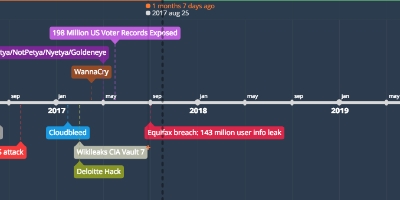23h 2min, oct 16, 2017 y - ROCA: Vulnerable RSA generation (CVE-2017-15361)
Description:
https://arstechnica.com/information-technology/2017/10/crypto-failure-cripples-millions-of-high-security-keys-750k-estonian-ids/?amp=1https://github.com/crocs-muni/roca
https://www.forbes.com/sites/thomasbrewster/2017/10/16/worse-than-krack-google-and-microsoft-patch-massive-5-year-old-encryption-hole/#34ae08a447c3
https://keychest.net/roca
A crippling flaw in a widely used code library has fatally undermined the security of millions of encryption keys used in some of the highest-stakes settings, including national identity cards, software- and application-signing, and trusted platform modules protecting government and corporate computers.
The weakness allows attackers to calculate the private portion of any vulnerable key using nothing more than the corresponding public portion. Hackers can then use the private key to impersonate key owners, decrypt sensitive data, sneak malicious code into digitally signed software, and bypass protections that prevent accessing or tampering with stolen PCs. The five-year-old flaw is also troubling because it's located in code that complies with two internationally recognized security certification standards that are binding on many governments, contractors, and companies around the world. The code library was developed by German chipmaker Infineon and has been generating weak keys since 2012 at the latest.
The flaw is the one Estonia's government obliquely referred to last month when it warned that 750,000 digital IDs issued since 2014 were vulnerable to attack. Estonian officials said they were closing the ID card public key database to prevent abuse. On Monday, officials posted this update. Last week, Microsoft, Google, and Infineon all warned how the weakness can impair the protections built into TPM products that ironically enough are designed to give an additional measure of security to high-targeted individuals and organizations.
https://crocs.fi.muni.cz/public/papers/rsa_ccs17
A newly discovered vulnerability in generation of RSA keys used by a software library adopted in cryptographic smartcards, security tokens and other secure hardware chips manufactured by Infineon Technologies AG allows for a practical factorization attack, in which the attacker computes the private part of an RSA key. The attack is feasible for commonly used key lengths, including 1024 and 2048 bits, and affects chips manufactured as early as 2012, that are now commonplace. Assess your keys now with the provided offline and online detection tools and contact your vendor if you are affected. Major vendors including Microsoft, Google, HP, Lenovo, Fujitsu already released the software updates and guidelines for a mitigation. Full details including the factorization method will be released in 2 weeks at the ACM CCS conference as 'The Return of Coppersmith's Attack: Practical Factorization of Widely Used RSA Moduli' (ROCA) research paper.
Added to timeline:
Date:
23h 2min, oct 16, 2017 y
Now
~ 8 years ago
